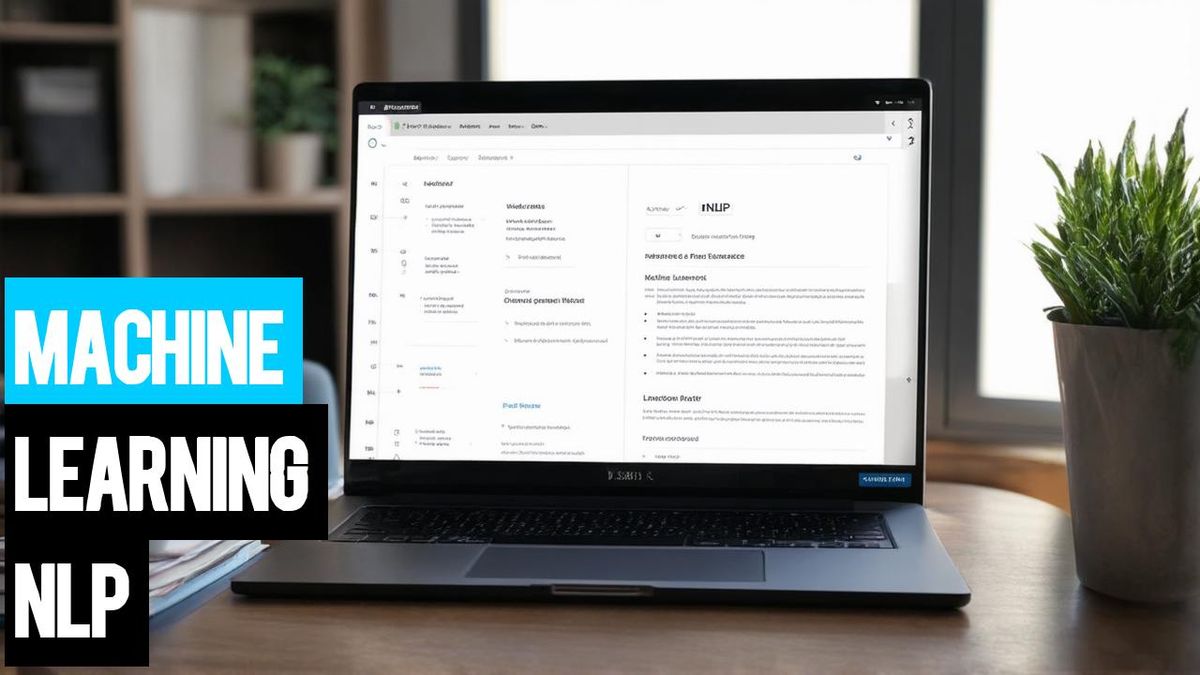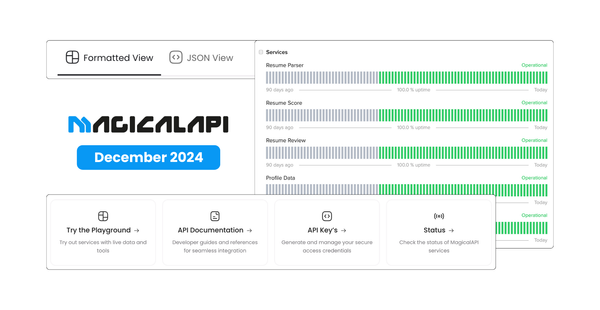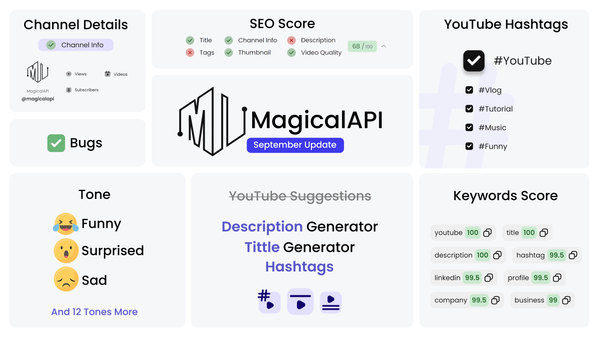What is a Resume Parser and How Does it Use Machine Learning and NLP?
Empower your job search journey! Dive into the future with our Resume Parser, using Machine Learning and NLP to elevate your career prospects

In the contemporary job market, the role of technology, especially machine learning (ML) and natural language processing (NLP), in streamlining recruitment processes is becoming increasingly significant.
One such area where ML and NLP are making a substantial impact is resume parsing.
This blog explores the intricate world of resume parsing using ML and NLP, detailing how it's revolutionizing the way recruiters process job applications.
✨ Unleash the Power of AI with MagicalAPI!
Whether you’re extracting LinkedIn data, or evaluating resumes, MagicalAPI is your one-stop solution! Discover the diverse range of AI services tailored to meet your every need. Dive in and elevate your digital experience today!

What is Resume Parsing?
At its core, resume parsing involves converting the unstructured data of resumes into a structured format.
This process is pivotal in recruitment, enabling the extraction of key candidate information without manually sifting through each resume. Such automation leads to more efficient and energy-saving recruitment processes.
The Role of Machine Learning in Resume Parsing
Machine Learning (ML) has significantly transformed the landscape of numerous industries, including human resources and recruitment. Its role in enhancing the capabilities of resume parsing technologies cannot be overstated.
Machine learning has transformed resume parsing from a manual and error-prone task to an automated and accurate process.
By analyzing resumes, ML models categorize them based on various parameters like skills, experience, and educational background. This categorization helps recruiters quickly identify the most suitable candidates for specific roles.
Integrating NLP in Resume Parsing
NLP's role in resume parsing is to understand and interpret the language used in resumes. Given that natural language is often unstructured and varies across different cultural contexts, NLP techniques are essential in extracting relevant information from various formatted resumes.
How Machine Learning and NLP Enhance Resume Parsing?
Machine Learning (ML) and Natural Language Processing (NLP) are at the forefront of transforming the recruitment process through advanced resume parsing technology. This synergy between ML and NLP provides a dynamic, efficient, and fair approach to sorting through the vast amount of data contained in resumes. Here's a closer look at how these technologies are enhancing resume parsing:
Streamlined Efficiency
ML algorithms automate the process of extracting key information from resumes, such as educational backgrounds, work experiences, skills, and certifications. This automation allows for the processing of a high volume of resumes in a fraction of the time it would take a human reviewer, significantly speeding up the recruitment process and ensuring no candidate is overlooked.
Improved Accuracy through NLP
NLP, a subset of ML, excels in interpreting the natural language found in resumes. It enables the resume parser to understand and contextualize the unstructured text, recognizing the significance of specific terms within the industry or job role context. This results in a nuanced and accurate assessment of a candidate's suitability for a position, enhancing the quality of candidate selection.
Bias Reduction
One of the significant advantages of employing ML in resume parsing is its contribution to a more objective and fair recruitment process. Traditional manual screening methods are prone to unconscious biases, but ML algorithms evaluate candidates based on predefined criteria related to the job requirements. This impartial evaluation promotes a fairer and more inclusive hiring process.
Adaptability to Changing Trends
The job market and resume formats are constantly evolving, and ML's adaptability ensures that resume parsing technology remains effective and relevant. ML algorithms learn from new data, adapting to new patterns in resume formats and job descriptions. This ensures that the parsing capabilities continue to meet the changing demands of the job market and the ways candidates present their information.

Future of Resume Parsing: Enhancing with Advanced Models
Looking ahead, the future of resume parsing involves enhancing the accuracy of these models, enabling multilingual parsing, and refining data extraction to include more entity types. The integration of advanced models like BERT in resume parsing is an exciting development, leveraging its pre-trained capabilities to further enhance parsing processes.
The Importance of Data for ML-Based Resume Parsing
For ML-based resume parsing to be effective, it requires a substantial amount of data to train the algorithms accurately. The process of creating this dataset is a blend of automated techniques and manual tagging, with tools like Doccano playing a significant role in reducing the time involved in manual tagging.
The Need for Manual Tagging
Despite the advancements in automated tagging, manual labeling remains a time-consuming yet crucial part of the data preparation process for ML-based resume parsing.
Nationality Tagging in Resume Parsing
Tagging nationality in resumes is a complex task due to the dual nature of terms like 'Chinese', which can refer to both a nationality and a language. Accurate nationality tagging is crucial for parsing resumes from a global talent pool.
Leveraging BERT in Resume Parsing
The incorporation of BERT, a pre-trained NLP model, in resume parsing, allows for leveraging the advanced NLP capabilities of the model. This inclusion has significantly improved the efficiency and accuracy of parsing resumes, enabling the extraction of detailed information such as skills, universities attended, degrees earned, and various social media links.
Benefits of Intelligent Resume Parsing Software
Intelligent resume parsing software offers numerous benefits. It streamlines the recruitment process by automating the parsing of thousands of resumes, thereby saving time and reducing complexity. Integration with Applicant Tracking Systems (ATS) further ensures a seamless evaluation process of job applicants, aiding recruiters in making more informed decisions.
Practical Applications of Resume Parsing
In practical applications, resume parsers categorize resumes into different job categories and extract crucial information like contact details, years of experience, and relevant skills.
This automated summarization and categorization of resumes not only saves time but also enables recruiters to identify suitable candidates for specific roles quickly.
Our Advanced Resume Parser Service
In response to the growing need for efficient and accurate resume parsing, we are proud to introduce our advanced Resume Parser service. Utilizing the latest ML and NLP technologies, our service offers unparalleled accuracy in parsing resumes, extracting essential candidate information, and categorizing it in a structured format. Our service is designed to streamline the recruitment process, enabling recruiters to focus on the most suitable candidates quickly.
Conclusion
The integration of machine learning and natural language processing in resume parsing represents a significant advancement in the field of recruitment. This technology not only saves time and resources but also enhances the accuracy of candidate selection. As we continue to witness advancements in ML and NLP, the capabilities of resume parsing will expand further, offering more sophisticated tools for HR professionals.
FAQ
- How does machine learning enhance resume parsing?
Machine learning (ML) significantly improves the accuracy and efficiency of resume parsing. By analyzing large datasets of resumes, ML models learn to identify patterns and extract relevant information such as job titles, skills, and education. - How do resume parsers handle different resume formats?
Resume parsers use Optical Character Recognition (OCR) to convert different formats of resumes (PDF, Word, etc.) into machine-readable text. NLP and ML algorithms then process this text to extract and structure the information. - How does a resume parser integrate with Applicant Tracking Systems (ATS)?
Resume parsers can be integrated with ATS platforms to streamline the recruitment workflow. Parsed data is organized into structured formats like JSON, XML, or CSV, which can be easily imported into ATS systems.

Join to our community
By joining our Discord server, get assistance, and troubleshoot any challenges you may encounter while using our services.
Join us on Discord




